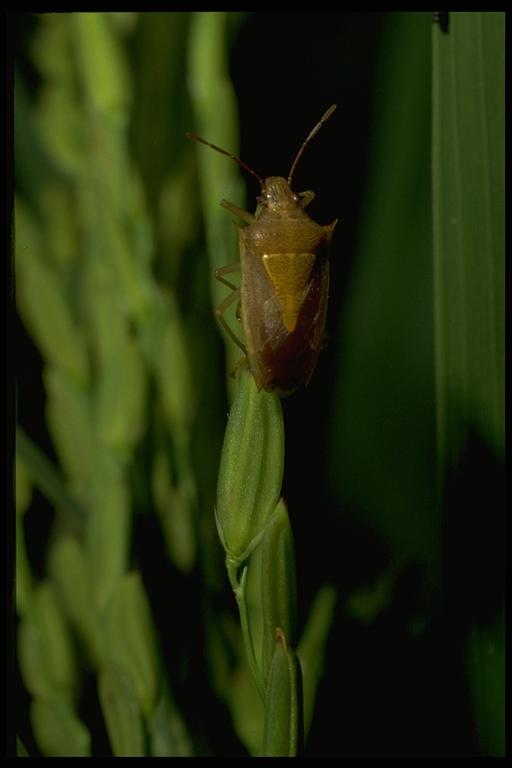
Rice stink bug, Oebalus pugnax (Fabricius) (Hemiptera: Pentatomidae), adult. Photo by Drees.
Common Name: Rice stink bug
Scientific Name: Oebalus pugnax (Fabricius)
Order: Hemiptera
Description: Adult rice stink bugs are straw-colored, 3/8 to 1/2- inch long, somewhat elongated and flattened with forward pointing spines on the shield-like segment behind the head (pronotum). Nymphs hatching from eggs are at first bright red with black markings. As they grow they begin to resemble adults but do not have fully developed wings or forward-pointing spines, but they have an intricate red and back pattern on the upper surface of their abdomens.
Life Cycle: Winter (October through April) is spent in the adult stage near the ground in wild grasses. In April and early May adults become active and mated females lay clusters of 10 to 30 light green barrel-shaped eggs arranged in double rows on leaves and seed heads (panicles) of wild grasses, sorghum and rice. Nymphs hatch in about 5 days. They molt five times as they grow over a period of 15 to 28 days before becoming adults. Development from egg to adult occurs in 18 to 50 days, depending on temperature. Up to 5 generations can develop annually, with two or three developing on sorghum and rice.
Habitat, Food Source(s), Damage: Rice stink bug adults migrate from wild grasses to sorghum and rice when plants begins to develop kernels or develop in and around fields on wild host plants. Wild host plants include barnyard grass and sedge (Cyperus sp.). Rice stink bugs can be collected from grasses with developing seed heads, such as Johnsongrass and rice.
Nymphal and adult feeding removes contents (endosperm) from developing seed (milk and soft dough stages) and results in an empty seed coat or shriveled kernels. Yellow to black spots develop at feeding sites on rice kernels injured later (dough stage) and are often associated with microorganisms. This type of damage is commonly called “pecky rice”, and it has been correlated with reduced head yield and increased percent broken kernels in milled rice, a loss in quality or “grade.”
Pest Status: Along the Texas coastal counties, rice stink bug nymphs and adults feed on developing sorghum rice kernels, causing loss of quality (grade) and yield; medically harmless.
For additional information, contact your local Texas A&M AgriLife Extension Service agent or search for other state Extension offices.
Literature: Drees et al. 1996; Naresh and Smith 1982, 1984; Nilakhe 1976; Peairs and Davidson 1956; Swanson and Newsom 1962.